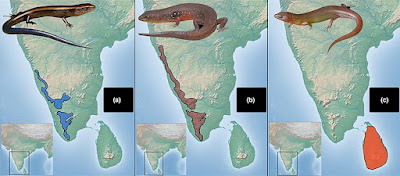 |
| Kaestlea, Ristella and Lankascincus in Ghosh, Sil, Ukuwela & Datta-Roy, 2023 DOI: 10.1111/zsc.12635 |
Abstract
The Western Ghats-Sri Lanka biodiversity hotspot is home to three endemic Lygosomine (Reptilia, Scincidae) skink genera—Kaestlea, Ristella and Lankascincus. Phylogenetic reconstructions in the past have suggested a sister relationship between the Western Ghats endemic Ristella and the Sri Lankan endemic Lankascincus, while the placement of Kaestlea has been uncertain. We reconstruct a global, genus-level, multi-locus phylogeny of the sub-family Lygosominae to ask if these endemic genera share an immediate common ancestor, that is, did they arise from a single dispersal event? Furthermore, to understand the possible centres of origin and dispersal routes of these three genera of Indo-Sri Lankan skinks, we construct a time-calibrated phylogeny and perform ancestral range evolution. We find that Kaestlea does not share an immediate ancestor with Ristella + Lankascincus. Therefore, their presence in the Indian subcontinent results from two independent colonization events. Both these dispersal events likely occurred during the late Palaeocene-early Eocene from the Asian landmass. Our molecular dating and ancestral range evolution analyses add further evidence of probable transoceanic dispersal in skinks and early land connections between the Indian subcontinent and Asia. It also reveals that these skinks were some of the earliest lizards to disperse into the Indian subcontinent.
Keywords: dispersal, early Eocene, late Palaeocene, Lygosominae, Kaestlea, Lankascincus, Ristella
Avrajjal Ghosh, Maitreya Sil, Kanishka B. Ukuwela and Aniruddha Datta-Roy. 2023. Independent Origins or Single Dispersal? Phylogenetic Study supports early Cenozoic Origin of Three Endemic Indo-Sri Lankan Lygosomine Skink Genera. Zoologica Scripta. DOI: 10.1111/zsc.12635
Researchgate.net/publication/374762333


